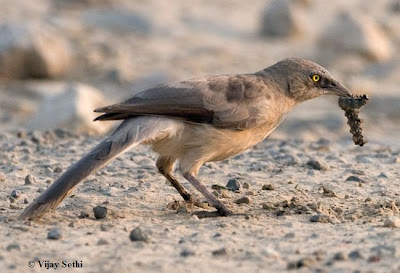Below is a fascinating narrative entitled, “A Family Dedicated to Birds” which goes into detail about Bal Pandi and explores the nesting habits of many of the bird species found at Koothankulam Bird Sanctuary.
To find out more about Koothankulam Bird Sanctuary and Bal Pandi’s work at that place, go to my previous link.
“Bal Pandi’s service to birds with love and affection like a mother is praiseworthy in this Twenty First Century. This is not only confined to him but his wife who is no more was also a great bird lover. The couple engaged themselves in feeding orphan chicks and bathing them. Whirlwinds with downpours may happen during April/May. At that time hundreds of chicks may fall from the nests of painted storks, pelicans, cormorants, openbills, spoonbills, darters and egrets. Once fallen the chicks become orphans and they will not be again able to return to the nest at any cost. So Bal Pandi rescues such orphans and nourishes with fish bought at the Koothankulam bird sanctuary, Tirunelveli District and secures them in cage. After three months the juveniles are freed to lead an independent life. Even after they leave the birds reared by Bal Pandi recognize him and come near and beat their wings and call expressing their gratitude.
 |
| Bal Pandi overseeing the Sanctuary |
The Governments of Tamil Nadu Forest Department engage the couple as contingent staff for the past 20 year with poor payments. Bal Pandi survives his wife with two sons and two daughters. A daughter has been married and recent demise of Mrs Vallithai his wife is a great loss to him as well as the birds. Many painted storks and egrets breed even in middle of his village. When a nest slides down he erects a pole to support it. Sometimes his pocket may not have any penny, but he would be fishing in the Koothakulam lake to feed fish to his orphan birds. Once when he got into a public bus to go the nearby Tirunelveli town, pelican juveniles also climbed into bus. Such a pure love he enjoyed from the birds he nourished. Birds have hearts full of thanks but humans alone may be thankless even to their own parents.
When I invite him to come to Coimbatore during the nesting season i.e. from March-July, he denies and the next minute he asks me who would look after his orphan birds. He moves closely with the orphanage birds, and his routine work is to watch for new incoming migratory birds and their number. He wants to know how they would live in that sanctuary and till which month. When will they leave for the foreign land? He safeguards foreign birds along with the local birds. Nearly 150 species of birds we may see in around Koothakulam. He planted a large number of trees with the assistance of the Forest Department and watered them. Of course! All his works were shared by his wife. He introduces the birds to the visitors of the sanctuary and safeguards the locality from humans and their herds.
 |
| Raising the young separated from their parents |
He is capable of writing and singing folk songs. While walking on the bund of the Sanctuary lake he used to sing these songs. In the last verse of his folk songs he sings that he likes to pass on from this world only from the bund of the Koothakulam lake. Every day early in the morning before the sun rises he walks along the bund of the lake, the narrow bunds of the paddy fields to reach Kadankulam to watch birds. He prepares a daily check list of birds and notes down in his diary. He is exposed to nature and has a deep knowledge about birds. He can identify birds without binoculars and spot hidden nests.
When a painted stork chick falls from the tree its leg maybe fractured and blood would be oozing from its beak. Bal Pandi does not hesitate seeing the filth but immediately takes a mouthful of water, puts his mouth over the beak of the swooned chick and forcibly pushes the water into the stomach of the bird. He wraps and sets the banana bark and ties with a thread to hold fractured leg in place. If a pelican falls from the tree, due to its weight and softness of the body, its belly may get ruptured. Bal Pandi, with a mother’s love, becomes a veterinary doctor, stuffs the organs back inside the belly and stitches it with nerve and pours water.
For a few weeks the wounded pelican is laid down on a sack so that worms and parasites will not infect the wound. He applies slag and residue of the grindstone to the wounds which heal very fast. In due course the stitches become absorbed into the bird’s body. Sometime the pelican chicks may eat clay due their enormous appetite. At that time he feeds them fish to avoid clay eating. Each and every species of birds has a variety of lice, flies and ticks which thrive on the blood of birds. Bal Pandi removes them by bathing the birds twice daily. At times these parasitic flies jump onto him and crawl all over his body. At once he runs to the lake and jumps in. In the same manner he takes care of openbills, spoonbills, cormorants, darters, night herons and egrets.
If chicks fall from the nests they all perish due to starvation. It is a pathetic scene to watch. Some orphan birds pick spilled fish from the nests above in the trees. A few days may pass like this. But dogs, foxes and raptors snatch away the chicks. The mother birds are incapable of carrying these chicks back to their nests. So the only source of hope for the fallen chicks to thrive in this world is Bal Pandi. I am really astonished at the blindness of conservation associations and charities of Nature who abstain from funding this meritorious service to Birds.
Birds and animals are quiet fond of the one who rescued and nourished them and repay thankfulness in all manners. The birds show their gratitude by calls, gestures and wing beats and they never forget. Whereas man will just say thanks for the moment and then think about spending the money received from the helpers. He even forgets his mother and father who brought him into this world and nourished him. Think about the Almighty! Can they at least thank the visible Nature?”
The writer of this narrative, Chinna Sathan has combined with Bal Pandi to write, “Diary on the Nesting Behaviour of Indian Birds”.
To find out more about this book and to order it visit the website at this link.
To read more about this extraordinary conservationist and the work he is doing at Koothankulam Sanctuary, please go to this link entitled, “Bal Pandi Saving a Paradise”.


















.jpg)






